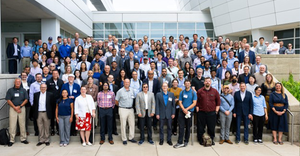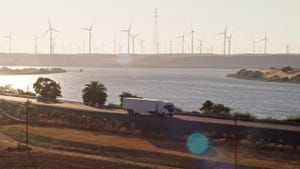Minnesota Pilots Innovative PFAS Treatment
Minnesota has become among the first U.S. investors in an Australian-born technology that leverages PFAS’s natural tendencies to remediate these toxic, persistent chemicals. Surface-Active Foam Fractionation (SAFF) removes PFAS from water and soil by pulling it from foam on water’s surface, where these compounds are known to concentrate.

Minnesota has become among the first U.S. investors in an Australian-born technology that leverages PFAS’s natural tendencies to remediate these toxic, persistent chemicals. Surface-Active Foam Fractionation (SAFF) removes PFAS from water and soil by pulling it from foam on water’s surface, where these compounds are known to concentrate. Minnesota chose the system based on findings from evaluations it performed as part of a 3M settlement after the state sued the corporation for disposing PFAS that impacted the region’s drinking water.
“We did a source assessment and feasibility study to evaluate where the PFAS was moving; where it could go in the future; and to understand potential clean up options,” says Rebecca Higgins, senior hydrogeologist, Minnesota Pollution Control Agency (MPCA).
Through that early work, the agency discovered high concentrations of PFAS residing in foam on surface water, sparking curiosity. The team began to search for more information about PFAS removal from water and to vet remediation technologies around the world.
Ultimately, MPCA selected SAFF, shown effective in regions with similar winter conditions that challenge the tasks of monitoring, testing, and treating water.
“This system mimics what we have seen mother nature do. It can concentrate PFAS in foam on water, and therein lies the opportunity to remove it. This is one of those early technologies we think is applicable to surface water conditions and potentially groundwater conditions,” Higgins says.
At high level, SAFF uses bubbles that rise through water columns. PFAS attaches to the bubbles, which foam at the top of the column, and are collected and concentrated.
In Minnesota, specifically the Northeast region involving the 3M settlement, PFAS emanates from two primary sources: Oakdale disposal site and Washington County landfill. Contaminated water flows into the latter from a creek and flows into the former from rainwater, and has ultimately moved into communities’ surface water and groundwater.
MPCA will begin with a pilot of SAFF at Tablyn Park in the city of Lake Elmo, where there are already easily accessible monitoring wells. Since the North Star state is in the dead of winter, the team will start with groundwater, which flows year-round, and then look at how the system does on creek surface water during springtime (freer-flowing) conditions.
“Depending on what we learn about how the system handles [either water source] other locations in the Metro Northeast region will be selected for additional testing to determine SAFF’s efficacy in different environments and conditions,” Higgins says.
The unit is mobile so it will be relatively easy to deploy at almost any chosen site.
EPOC, an environmental engineering firm, has processed over 100 million gallons of contaminated liquid globally, successfully removing regulated PFAS compounds in each case (generally PFOS, PFOA, and PFHxS), according to Peter Murphy, president of EPOC Enviro.
EPOC launched the first commercial-scale treatment plant in 2018 and then began containerizing units and shipping them around the world in 2020.
The three systems operating in the U.S. – the Minnesota project, one at a landfill in Vermont, and another at a water treatment center in Michigan—will be followed by 12 units on backorder. And a manufacturing facility is slated to launch in North Carolina in March 2023, which Murphy says will make 100 units a year.
U.S. interest has been strong, he says, particularly in the Northeast, which he has noticed tends to be fairly progressive in their response to environmental issues and is motivated as it is impacted by the volume of manufacturing plants operating there.
“Landfills in the Northeast tend to have the worst contamination issues. With increasing state and federal regulations, and as wastewater treatment plants tighten discharge limits, these service providers have to find solutions, he says.
As scrutiny escalates around PFAS, much of the rest of the country is beginning to follow suit, turning its attention to the infamous forever chemicals. Murphy calls out these compounds as contributors to the greatest environmental and health problems since asbestos and polyvinyl chloride (PVC), which like PFAS are associated with multiple health conditions and diseases.
He anticipates more demand for technologies like SAFF as new Environmental Protection Agency (EPA) rules come into play, the most imminent being maximum contaminate levels (MCL) to be implemented by fall of 2023 around several PFAS compounds.
The MCL for some constituents will be 4 picograms. For perspective: one picogram is equal to one trillionth of a gram.
“That’s substantially less than one drop in an Olympic pool. EPA is basically saying if it can be detected it’s too much,” Murphy says.
He pitches SAFF as an alternative to ion exchange and granular activated carbon, which leverage a medium that adsorbs PFAS in liquids these technologies treat. The adsorbent media get saturated quickly. Landfills are spending a fortune on replacements, Murphy says.
Reverse osmosis, whereby leachate flows through a membrane and PFAS gets filtered out, is typically considered more viable, but also leaves contaminant-laden residue. SAFF treats the brine water and removes the PFAS, leaving no solid waste.
In Minnesota, Higgins and her team are keeping their eyes wide open to other technologies on the market and those that may soon roll out, anticipating they will need to pair systems, depending on PFAS mix, location, and other variables.
SAFF is looking promising so far following predictability studies and bench-scale tests in a lab setting.
“Now we will see how it handles real-world conditions,” Higgins says.
Minnesota has purchased the system and has ongoing support from its state contractor, AECOM, who works closely with EPOC in Australia and with EPOC’s North American distributor, Allonnia.
“There will be lessons learned on how it performs, and we will take those lessons to figure out how to optimize the system for various conditions and the PFAS mixture we are working with,” Higgins says.
Plans are to train staff in remediation who oversee the state’s landfills. And to offer tours to the public in time.
“We hope to be able to share information,” she says.
About the Author
You May Also Like




